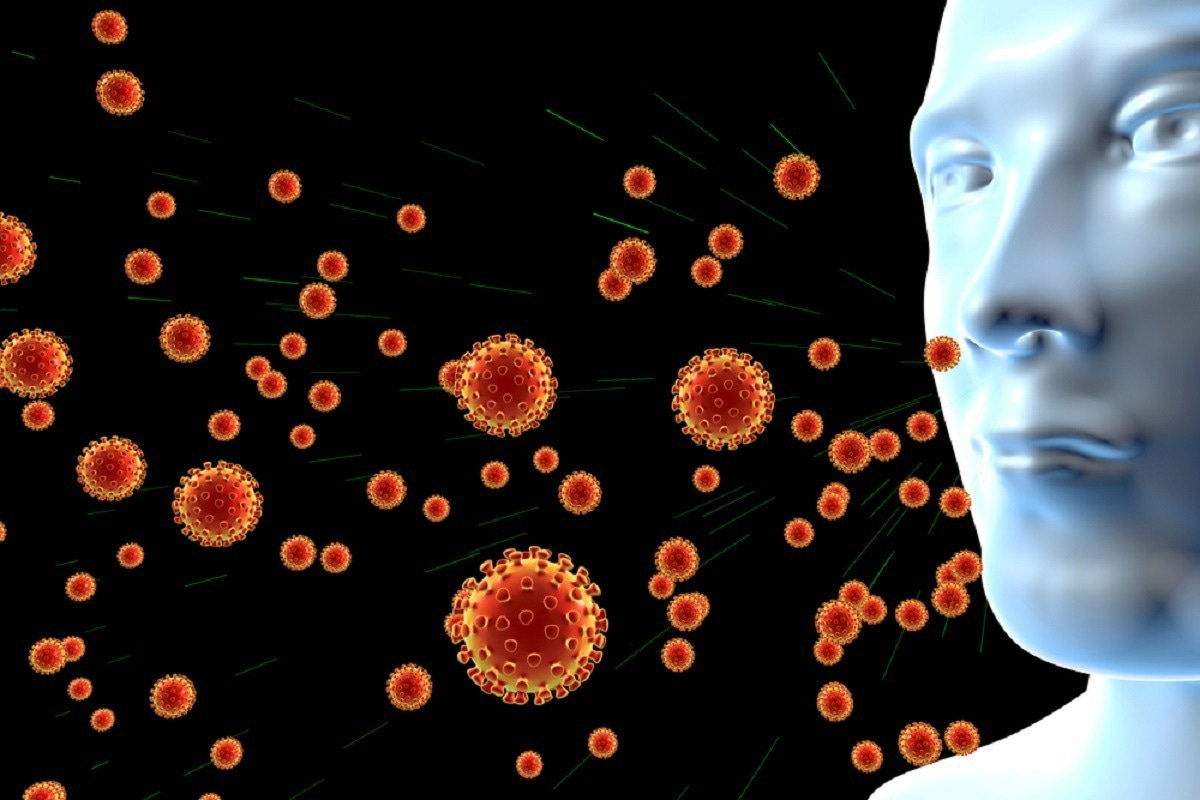A recent article published in the medRxiv* preprint server analyzed the severe acute respiratory syndrome coronavirus 2 (SARS-CoV-2) shedding evolution in exhaled breath aerosols (EBA).

Background
The inhalation of aerosols is now widely acknowledged as a significant, if not the major, method of SARS-CoV-2 transmission. Three highly transmissible SARS-CoV-2 lineages, namely B.1.1.7 (Alpha), B.1.617.2 (Delta), and B.1.1.529 (Omicron), evolved throughout the coronavirus disease 2019 (COVID-19) pandemic course and dominated globally in 2021.
Various reports indicate that successive SARS-CoV-2 variant of concern (VOC) harbors higher transmissibility than the ancestral strains or prior variants. One explanation for improved transmissibility is the enhanced viral aerosol shedding by variants favored by natural selection. Nevertheless, the degree of aerosol shedding of each subsequent SARS-CoV-2 variant is uncertain. Additionally, it is unclear whether the ongoing evolution of succeeding variants and subvariants, which appear to be gradually more transmissible, is connected to the continued boosting in aerosol shedding rate.
About the study
In the current work, the researchers reported analyses of the shedding rate of SARS-CoV-2 into EBA by people with ancestral strain, variants without high transmissibility, Omicron, Alpha, and Delta infections. Besides, they contrasted viral aerosol shedding rates between Omicron subvariants. Furthermore, using information from the present study and the authors' earlier paper on EBA viral loads, the team addressed the changing frequency of the aerosol shedding of SARS-CoV-2 throughout the initial two COVID-19 pandemic years.
People experiencing an active COVID-19 verified by a recent polymerase chain reaction (PCR) screening were enrolled for the study between 6 June 2020 and 11 March 2022. A preliminary questionnaire was used to gather basic demographic information, including vaccination records. Subjects were sampled one to 13 days after the onset of the symptoms. On each day that samples were collected, the participants filled out an online form to revise the status of their symptoms and list any medications administered.
On a scale of zero to three, subjects self-reported the 16 symptoms. Subsequently, the investigators determined separate composite symptom scores for upper respiratory, lower respiratory, systemic, and gastrointestinal symptoms.
Subjects participated in loud singing and speaking protocols while providing mid-turbinate swabs (MTS), saliva, phone swabs, venous blood samples, and EBA samples at viral shedding assessment sessions. Further, SalivaDirect was used to process the saliva.
Results
The study results showed that two-dose COVID-19 (fully) vaccinated and SARS-CoV-2 Delta-infected and two-dose plus booster vaccinated individuals infected by Omicron variants emitted infectious viral aerosols. Assessing ribonucleic acid (RNA) copies of the highly transmissible Delta, Alpha, and Omicron variants indicated that their infections caused drastically elevated shedding of viral aerosols compared to SARS-CoV-2 ancestral strains and non-highly contagious variant infections. These findings suggest that a high aerosol viral shedding rate was a feature of highly transmissible SARS-CoV-2 variants.
The three significantly contagious variants (Delta, Alpha, and Omicron) come from three different SARS-CoV-2 clades, each independently developed elevated shedding phenotypes. This proof of concurrent evolution of enhanced viral aerosol shedding was in line with the idea that airborne transmission, described as the inhaling viral aerosols irrespective of the distance the aerosol traveled, played a dominating role in the COVID-19 spread.
An Omicron-infected subject was the top viral EBA shedder, whose fine EBA sample comprised 1.8×107 RNA copies, which was three orders of magnitude more than the peak value seen for infections with the Delta and priorly described Alpha variant cases. However, the team found no statically significant variations in the geometric mean rates of SARS-CoV-2 RNA shedding to EBA across the three highly transmissible variants.
Conclusions
Collectively, the present research demonstrated that compared to infections with SARS-CoV-2 ancestral strains and variants not linked to increased transmissibility, viral shedding, quantified as RNA copies in EBA, was considerably higher during the Delta, Alpha, and Omicron variant infections. The phenotype of robust viral aerosol shedding was separately evolved in the three highly transmissible variants (Delta, Alpha, and Omicron), exhibiting convergent evolution.
The team found no statistically relevant changes in the shedding rates between infections with Delta, Alpha, and Omicron. Yet, the highest shedder in the current study was infected by Omicron and shed thrice higher magnitude orders of viral RNA copies than the maximum recorded for Delta and Alpha.
According to the study findings, COVID-19 two-dose and booster-vaccinated people might shed infectious SARS-CoV-2 through their EBAs following SARS-CoV-2 infection. The study data contribute to the body of information showing that the primary route of SARS-CoV-2 transmission is through infectious aerosol inhalation and highlight the significance of filtration, ventilation, and air disinfection in containing the pandemic and safeguarding vulnerable populations. The authors assume that in the future, threat evaluations will likely include tracking aerosol shedding from novel SARS-CoV-2 strains and emerging pathogens, which will help direct efforts to stop transmission by inhalation exposure.
*Important notice
medRxiv publishes preliminary scientific reports that are not peer-reviewed and, therefore, should not be regarded as conclusive, guide clinical practice/health-related behavior, or treated as established information.
- Lai, J. et al. (2022) "Evolution of SARS-CoV-2 Shedding in Exhaled Breath Aerosols". medRxiv. doi: 10.1101/2022.07.27.22278121. https://www.medrxiv.org/content/10.1101/2022.07.27.22278121v2
Posted in: Medical Science News | Medical Research News | Disease/Infection News
Tags: Blood, Coronavirus, Coronavirus Disease COVID-19, covid-19, Disinfection, Evolution, Frequency, Omicron, Pandemic, Phenotype, Polymerase, Polymerase Chain Reaction, Research, Respiratory, Ribonucleic Acid, RNA, SARS, SARS-CoV-2, Severe Acute Respiratory, Severe Acute Respiratory Syndrome, Singing, Syndrome

Written by
Shanet Susan Alex
Shanet Susan Alex, a medical writer, based in Kerala, India, is a Doctor of Pharmacy graduate from Kerala University of Health Sciences. Her academic background is in clinical pharmacy and research, and she is passionate about medical writing. Shanet has published papers in the International Journal of Medical Science and Current Research (IJMSCR), the International Journal of Pharmacy (IJP), and the International Journal of Medical Science and Applied Research (IJMSAR). Apart from work, she enjoys listening to music and watching movies.
Source: Read Full Article



